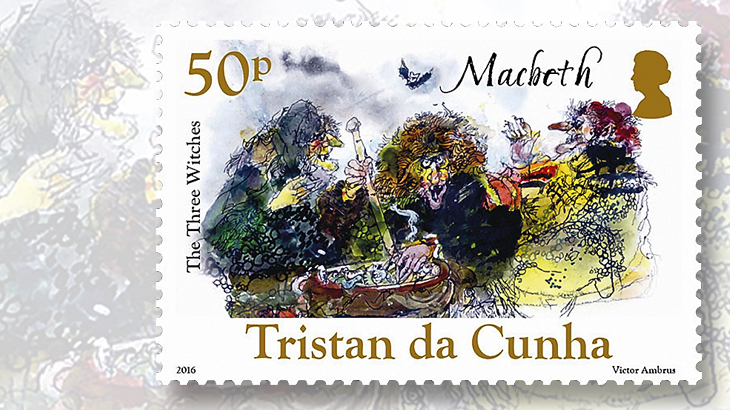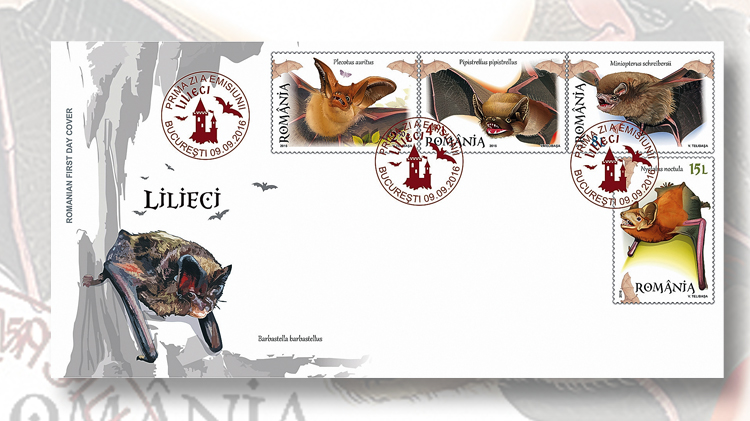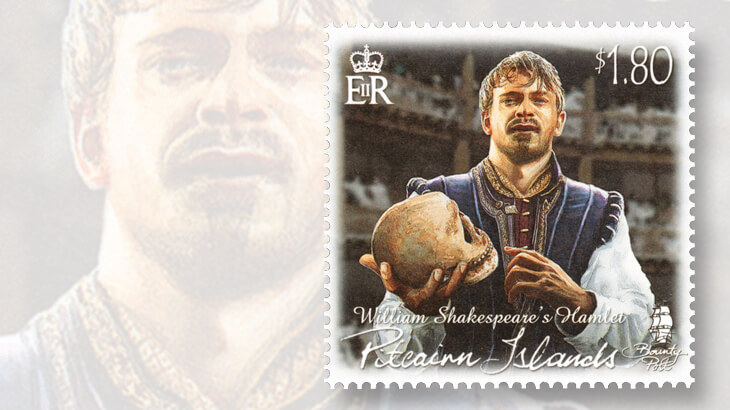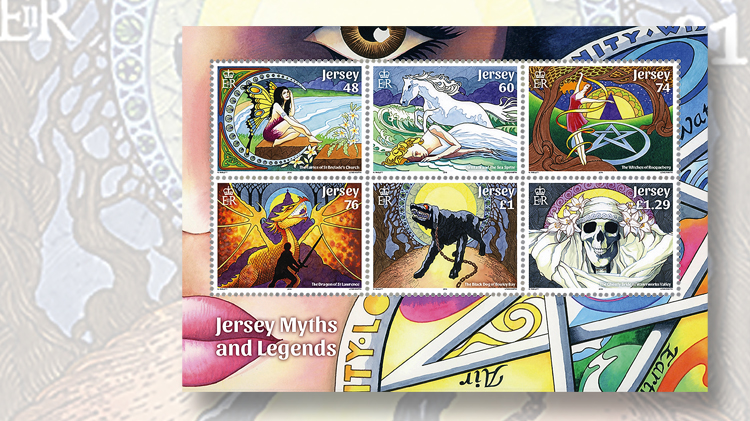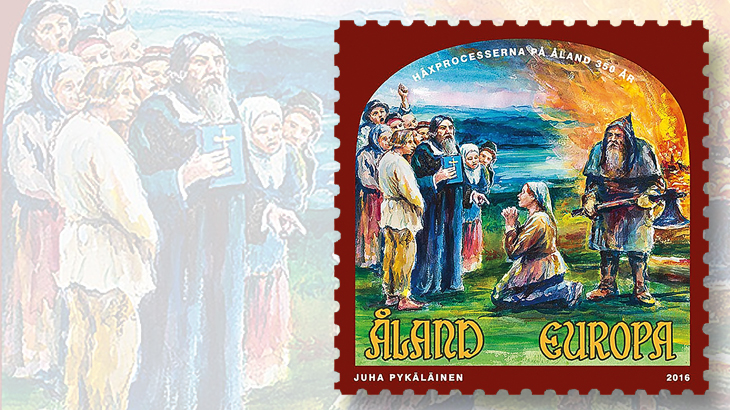World Stamps
The spooky subjects that are featured on new stamps of the world
By Denise McCarty
Six recent stamps from Jersey illustrate some of the local myths and legends of this island in the English Channel.
The 48-penny low denomination of this set issued Oct. 6 is inscribed “The Fairies of St. Brelade’s Church.”
According to this legend, the original site selected for the church was in an area considered special by the fairies. Every time construction would begin, the fairies would move the workmen’s stones, tools and even the foundation until the message was finally received to build the church elsewhere.
The next stamp, a 60p denomination, depicts the legend of William and the sea sprite.
Connect with Linn’s Stamp News:
Sign up for our newsletter
Like us on Facebook
Follow us on Twitter
In this folk tale, a sea sprite wanted to eliminate William, the beau of a woman the sprite wanted for his wife. To do this, the sprite transformed himself into a horse that was presented as a gift to William.
However, while riding the horse, William realized the deception, beat the horse with mistletoe and the sprite turned into a rock in Bonne Nuit Bay.
The 74p stamp shows one of the witches of Rocqueberg. In this tale, a young man thinks he is dancing with beautiful women near Rocqueberg Point, but they were actually old witches.
The myth of the dragon of St. Lawrence is illustrated on the 76p stamp. This tale involves the seigneur de Hambye of Normandy who slew a violent dragon. However, the seigneur’s squire then killed his master, took credit for slaying the dragon, and married the widow. After the squire’s trickery was discovered and he was executed for his crime, the widow had a memorial mound built on the site where the seigneur died. The mound is now known as La Hougue Bie.
The £1 stamp shows the black dog of Bouley Bay. An article on the website of the Jersey Evening Post describes this creature: “A giant dog with eyes as big as saucers and long sharp teeth was said to roam the beach terrifying anyone foolish enough to be in the area. One theory is that the beast was dreamt up by smugglers in order to keep people away from the bay so that they could get on with their illegal activities.“
On the £1.29 denomination, a skull wearing a veil adorned with flowers represents the ghostly bride of Waterworks Valley.
According to the local legend, a bride who killed herself after being jilted on her wedding day appears in a phantom carriage each year on the anniversary.
For more information about these and other local lessons, visit the BBC’s web page about Jersey folklore.
Nick Parlett designed the stamps. Lowe-Martin of Canada printed them by offset in sheets of 10 and in a souvenir sheet with the six designs se-tenant (side-by-side).
William Shakespeare
More skulls and witches can be found on stamps from Ascension Island, Pitcairn Island, and Tristan da Cunha marking the 400th anniversary of the death of William Shakespeare.
Book illustrator Victor Ambus created the designs for the Ascension Island and Tristan da Cunha stamps. His illustrations represent characters from Shakespeare’s plays.
The 65-penny Ascension Island stamp features Hamlet and shows the title character in a graveyard holding the skull of the court jester Yorick (act 5, scene 1).
On the 50p stamp from Tristan da Cunha, the three witches from Macbeth are stirring a boiling cauldron of toads, snakes, and other creatures while a bat flies above them.
The other plays and characters featured on these two sets are Malvolio from Twelfth Night (50p), Henry V (55p) and Romeo and Juliet (£1.60) on stamps from Ascension Island; and Bottom, Titania and Puck from A Midsummer Night’s Dream (35p), Ophelia from Hamlet (£1), and Falstaff from The Merry Wives of Windsor (£1.20) on stamps From Tristan da Cunha.
The stamps from Ascension Island were issued Aug. 8, and those from Tristan da Cunha on July 4. BDT International Security Printing printed them by offset in sheets of 10.
Pitcairn Island issued five Shakespeare stamps March 9. The $1 and $1.80 denominations feature the three witches and Hamlet with Yorick’s skull, respectively.
Aland
Aland offers a historic view of witch trials on a stamp issued April 8.
This nondenominated stamp paying the basic rate to European countries marks the 350th anniversary of a witch hunt that began in 1666.
The design depicts a scene before the execution of Karin Persdotter for witchcraft.
Aland Post reported that Persdotter “was accused of practising sorcery; she was thought to be able to find lost items, single out thieves and foresee who was going to die. From whom had she received the gift if not from the Devil? Convicted of witchcraft, she was condemned to be executed by axe and burnt at the stake.”
While awaiting her execution she was visited by district judge Nils Psilander and a local pastor, Bryniel Kjellinius, who convinced her to inform on 13 other women. In addition to Persdotter, six other women were executed for witchcraft in Aland between 1666 and 1670.
Juha Pykalainen designed the stamp. Cartor Security Printing printed it by offset in sheets of 30 (two panes of 15).
Romania
Four species of bats are pictured on a set of stamps issued Sept. 9 by Romania: the brown long-eared or common long-eared bat (Plecotus auritus), 2.50 lei; common pipistrelle (Pipistrellus pipistrellus), 4.50 lei; common bent-wing bat (Miniopterus schreibersii), 8 lei; and common noctule (Nyctalus noctula), 15 lei.
In announcing these stamps, Romania’s philatelic bureau, Romfilatelia, addressed some myths associated with these flying mammals: “From flying rats that get caught in human hair, messengers of evil and dirty creatures by their nature, the myths about bats are numerous, however the real and known features of these mammals come to contradict the popular beliefs.”
Romfilatelia also said, “[B]ats are actually capable of altruism, helping colony members who were not able to hunt with food. They also spend much of their resting time by cleaning their fur, like cats do, to ensure their health and that of the entire colony.”
As to being related to rodents, the Bat World website, said, “Bats are not flying mice; they are not even remotely related to rodents. Bats are such unique animals that scientists have placed them in a group all their own, called ‘Chiroptera’, which means hand-wing. Bats are grouped with primates and lemurs in a grand order called Archonta.”
Victor Telibasa designed the stamps. They were printed by offset in sheets of 32, miniature sheets of five stamps and a label, and in a souvenir sheet with the four stamps se-tenant.
MORE RELATED ARTICLES
Headlines
-
US Stamps
Oct 7, 2024, 3 PMMcMurtrie dismissed as APS education director following Sept. 21 arrest
-
US Stamps
Oct 7, 2024, 12 PMVasiliauskas named president of Mystic Stamp Co.
-
US Stamps
Oct 6, 2024, 5 PMApgar souvenir card available
-
US Stamps
Oct 6, 2024, 4 PMFirst Continental Congress and U.N. stamps receive Scott catalog numbers
